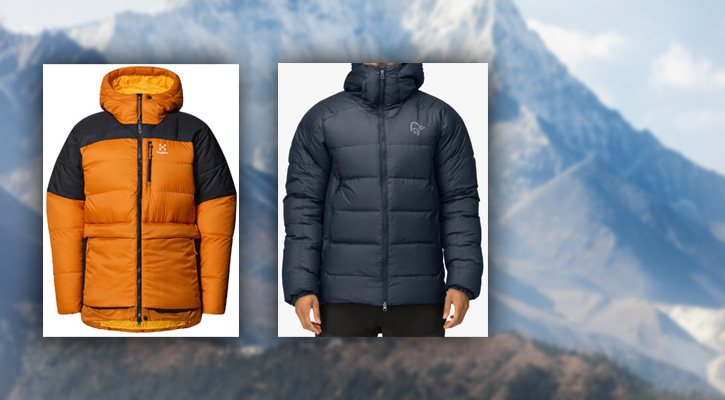
Two European brands that are consistently among the best companies for quality outdoor gear are Haglöfs and Norrøna.
But which is better?
Both have long histories of pioneering technical equipment. But there are also many characteristics that set them apart.
In this comparison, we’ll explore their histories, materials, and some example products, and consider which might be the optimal choice depending on your priorities and budget.
Let’s get started!
Contents:
1. Haglöfs Outdoor Gear
History of the Brand
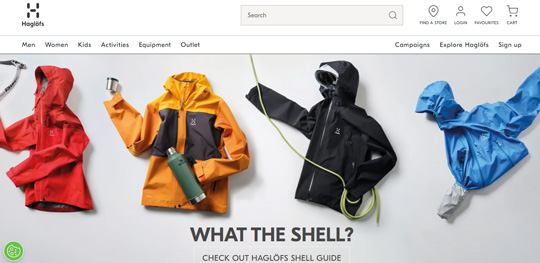
Haglöfs official website
In 1914, Wiktor Haglöf, a skilled carpenter, established the Haglöfs brand in Sweden with the goal of developing a durable backpack suitable for all types of travel within the nation.
Since then, Haglöfs has expanded its product collection and remains focused on pioneering advancements in craftsmanship. Haglöfs is deeply committed to conserving natural environments for the benefit of future generations.
The brand encourages both physical and mental exploration of the outdoors, believing that everyone should have the opportunity to connect with nature, irrespective of the weather and experience level.
Don’t miss:
10 Outdoor Brands like Haglöfs: Our Top Alternatives
9 Swedish Outdoor Clothing and Jackets Brands: Our Favorites
Materials, Fabrics, and Production Process
Haglöfs has set a target to reduce its carbon footprint by 50% before 2030. The company is dedicated to utilizing sustainable materials and renewable energy and enhancing energy efficiency to achieve this goal.
Moreover, Haglöfs is actively engaging with consumers to minimize their environmental impact. They are incorporating recycled and natural materials such as organic cotton, hemp, and Lyocell/Tencel into their products for outdoor activities and sports out in nature.
Additionally, the company is employing eco-friendly dyeing methods and reducing the use of plastic bags. Haglöfs is committed to responsible management of chemicals, water, and energy in their production facilities. The brand also evaluates the sustainability of its products throughout their life cycle using the Higg Index.
In sourcing animal-based materials, Haglöfs prioritizes suppliers that adhere to best practices in animal welfare and ecosystem preservation. For example, the natural down used for insulation is certified by the Responsible Down Standard (RDS) to ensure ethical means of sourcing.
Haglöfs also integrates various technologies in its products to provide protection, warmth, and breathability, including Recycled Polyamide (Nylon), Recycled Polyester, Mimic PLATINUM Ultracluster Graphene insulation, Polartec performance fabrics, Pertex fabrics, and GORE-TEX membranes in their jackets.
The video will be loaded from YouTube.com, a third party. If you play it, you accept their terms of service, and their use of cookies.
Read also:
Haglöfs vs North Face: Which is Better?
Haglöfs vs Arc’teryx Outdoor Gear: Which Brand is Better?
Where is Haglöfs outdoor gear made?
Haglöfs items are mostly produced in Asian nations like China and Vietnam, as well as in European countries such as Poland and Romania. The company’s dedication to maintaining superior standards has bolstered its appeal in numerous places and communities, particularly in Scandinavia.
Recommended Products
Haglöfs Men’s Riksgränsen Down 850 Hood Jacket
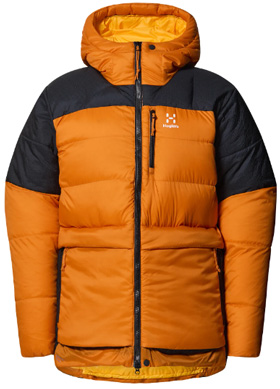
Image: haglofs.com
Check it out at Haglofs.com
The Riksgränsen Down 850 Hood Jacket for men is specifically crafted for freeride skiing and snowboarding in chilly conditions. It utilizes 850-fill-power goose down insulation to deliver exceptional warmth, and the down is water-repellent.
The jacket boasts a relaxed and comfortable fit, featuring reinforced shoulders for added protection. It includes an oversized hood that is compatible with helmets and comes with an adjustable brim for convenient one-handed operation.
For storage, it offers hand pockets, a chest pocket, and an inner mesh pocket. The cuffs are elastic, and the hem is customizable for a personalized fit. Constructed from recycled and bluesign-approved materials, the jacket compresses down small for easy packing into its accompanying pack bag.
Haglöfs L.I.M 35 Hiking Backpack
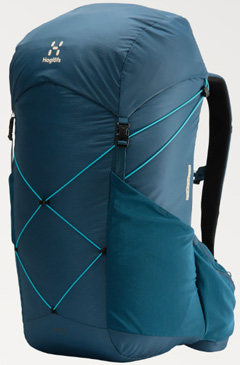
Image: haglofs.com
Check it out at Haglofs.com
The Haglöfs L.I.M 35 Hiking Backpack is a lightweight pack crafted for trekking and hiking, weighing 920 grams and offering a 35-liter capacity. It incorporates an Airback suspension system to ensure comfort during rigorous activities by facilitating airflow through the back contact area.
It comes with elastic side pockets, zippered elastic hip belt pockets, and a flexible cord for compression and gear attachment. The backpack is compatible with hydration systems, featuring a fixed top lid with a pocket, adjustable sternum strap, padded hip belt, and load lifters.
Made of bluesign-approved 70D*140D Diamond Rip-stop Nylon, it prioritizes durability and sustainability.
Prices
Haglöfs offers products within the mid-to-high price range. Their jackets are priced between $100 and $800. The most advanced and technical coat designs are those that cost the most. The range for bags and backpacks begins at $60 and can reach $300.
Are Haglöfs products worth the price?
Yes, in our opinion! Given the multitude of innovative technologies, an emphasis on environmental responsibility, and a diverse selection of outdoor equipment, we think this brand is a good investment if you’re an outdoor enthusiast.
Learn more: Why is Haglöfs so Expensive? Is Their Gear Worth It?
2. Norrøna Outdoor Gear
History of the Brand
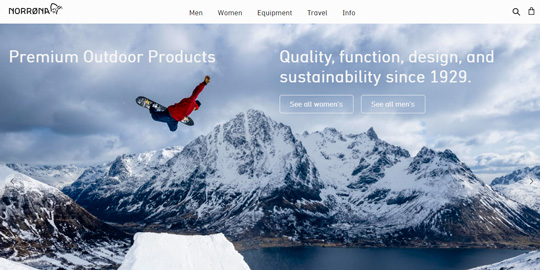
Norrøna official website
In 1929, Norwegian outdoor enthusiast Jørgen Jørgensen embarked on a quest to find durable outdoor gear suitable for Norway‘s challenging conditions. This marked the genesis of Norrøna as he began crafting basic items such as canvas backpacks, leather straps, and cotton clothing.
In 1948, Bjarne Jørgensen, the second generation Jørgensen, assumed leadership of the company. Over the following years, Norrøna diversified its product range and shifted its focus to technical functionality and mountain equipment.
By 1971, Ole Jørgen Jørgensen, the third generation Jørgensen, took over as manager. Additionally, engineer Tomas Carlstrøm was recruited to aid in the development of backpacks and mountain tents.
Throughout the 1970s and 1980s, Norrøna gained popularity for pioneering products and sponsoring expeditions. Notable achievements included the introduction of the first tunnel tent in 1972, Europe’s first Gore-Tex jacket in 1977, and the provision of gear for the winter ascent of Trollveggen in 1979.
In 2000, design became Norrøna’s third cornerstone, characterized by the philosophy of Loaded Minimalism, emphasizing clean, functional design. The company began international expansion in the mid-2000s, opening new collections and stores in Europe and North America.
In 2015, sustainability was incorporated as Norrøna’s fourth cornerstone, with a commitment to transparency and a pledge to donate 1% of sales to environmental causes.
Today, four generations later, Norrøna remains a family-owned enterprise headquartered in Norway. Under the stewardship of current manager Jørgen Jørgensen, the company continues to innovate technical outdoor gear rooted in Norwegian traditions.
Don’t miss: 9 Brands like Norrøna: Our Best Alternatives
Materials, Fabrics, and Production Process
Norrøna prioritizes the use of high-performance, sustainable materials in their product line. They are at the forefront of incorporating eco-friendly fabrics such as organic cotton, recycled polyester and nylon, as well as down insulation that adheres to the Responsible Down Standard (RDS) guidelines.
Additionally, they utilize Bluesign-approved fabrics, demonstrating their dedication to transparency and sustainable practices. Norrøna is recognized for its 100% organic cotton usage and high utilization of recycled polyester.
The company actively participates in initiatives like the Fashion for Good organization to advocate for sustainability. Through their 1% for Nature program, they contribute 1% of annual sales to environmental causes and organizations focused on nature conservation.
Norrøna strives for complete transparency in its sourcing and manufacturing processes, with sustainability serving as a fundamental pillar of its business philosophy.
Their commitment to developing technical products while emphasizing eco-friendly materials and reducing environmental impact underscores their dedication to both performance and the planet. This commitment is evident in their leadership in sustainable outdoor apparel and gear.
Like other reputable outdoor brands, Norrøna incorporates innovative fabric technologies and materials, including various versions of Gore-Tex membranes, Polartec performance fabrics, and PrimaLoft synthetic insulation.
The natural down sourced for insulation originates from the Pyrenees mountains in France, and the bird treatment complies with European standards.
The video will be loaded from YouTube.com, a third party. If you play it, you accept their terms of service, and their use of cookies.
Read also: Norrøna vs Arc’teryx Women’s Ski Jackets: Which Brand To Choose?
Where is Norrøna outdoor gear made?
Norrøna’s outdoor equipment is produced in various factories across Europe and Asia. At the moment of writing the brand utilizes manufacturing facilities in Lithuania, Spain, Portugal, Denmark, and Sweden within Europe, and in Asia, production takes place in Vietnam, China, and Thailand. (source)
Recommended Products
Norrøna trollveggen down 850 Men’s Jacket
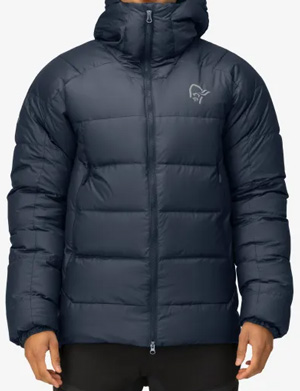
Image: norrona.com
Check it out at Norrona.com
The Norrøna trollveggen down 850 Men’s Jacket represents a high-quality mountaineering down jacket crafted with aeroDownproof face fabric and packed with RDS-certified 850+ fill power down to provide exceptional insulation without adding excessive weight.
It incorporates wind-resistant Pertex Quantum 30D 100% recycled polyester face fabric, 100g PrimaLoft Gold insulation within the pockets and on the shoulders, functional hand-warming pockets, an insulated hood, and an extended back length for added weather protection.
Read also: 10 Norwegian Jackets and Clothing Brands that You’ll Love
Norrøna lyngen 40L Pack
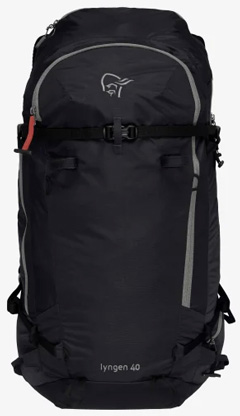
Image: norrona.com
Check it out at Norrona.com
The Norrøna Lyngen 40L Pack is a lightweight and robust backpack specifically crafted for ski touring, mountaineering, and trekking. Constructed from resilient ECONYL® material using closed-loop regeneration processes, it ensures durability and sustainability.
This pack boasts water-resistant properties, premium YKK zippers, and a well-ventilated back through an open-back design. It’s equipped with dedicated compartments for avalanche gear, crampons, and a rope, and is optimized for transporting ski and snowboard equipment.
It also features compression straps, a hip belt with a pocket, ice ax attachments, and a chest strap. The adjustable shoulder straps are designed with a 3D construction to enhance breathability.
Read also: 3 Best Norwegian Backpack Brands: Our Top Picks
Prices
Norrøna produces long-lasting and comfortable outdoor equipment crafted from high-quality materials, designed to endure demanding conditions. Customers express a sense of being well-supported and capable of peak performance even in the most extreme environments, thanks to Norrøna’s meticulous engineering and design.
But the upfront cost is higher than many competitor companies. Their jackets cost from $300 to over $1000. Their backpacks from $100 to $700.
Are Norrøna products worth the price?
We think Norrøna’s jackets and outdoor gear are worth their price if you’re into serious outdoor activities and want products that will last you for years. The company incorporates cutting-edge technology to produce high-quality jackets renowned for their warmth and comfort. Also, Norrøna offers vibrant designs not commonly found in other brands.
But, for casual outdoor activities or if you’re embarking on a new sport, you may want to consider other more affordable brands.
Learn more: Why is Norrøna so Expensive? Are Their Jackets Worth It?
3. Which is Better? Haglöfs or Norrøna?
While both are great, here are some things to keep in mind to help you decide which is better for you:
Haglöfs is a Swedish brand founded in 1914 that has a long history in outdoor gear design. They’re known for durable, functional clothing and equipment meant to withstand Nordic conditions like insulating layers, rainwear, jackets, backpacks, hiking shoes, and more.
Haglöfs gear tends to be on the more affordable side compared to some niche brands, making them a reliable option for the basics.
Norrøna is a Norwegian brand founded in 1929, also drawing from Scandinavian heritage in cold weather sports. They specialize more in technical mountaineering, skiing, and winter gear, using high-performance fabrics and designs optimized for those activities in Nordic climates.
Norrøna‘s product range is narrower and focused on hard alpine pursuits rather than casual hiking. Materials and construction result in higher prices than those of Haglöfs.
Both use innovative technologies and materials like Gore-Tex, PrimaLoft, Polartec, Pertex, Haglöfs MIMIC, etc. Both have advanced sustainability programs.
In the end, Haglöfs offers a broader assortment of durable, more affordable gear suitable for general outdoor use. Norrøna is better if you need specialized equipment pushed to the highest level for skiing, ice climbing, or mountaineering in extreme cold, though at a higher price.
Let us know what you think in the comments.
Read next: 10 European Down and Puffer Jacket Brands for Winter
